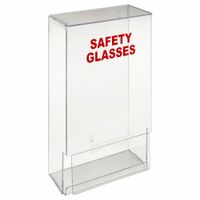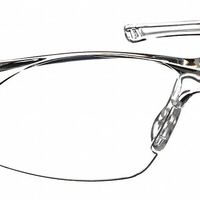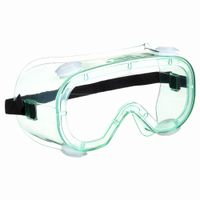Call +(254) 703 030 000 / 751 483 999 / 721 704 777
.....Read More
Frequently Asked Questions
What are the types of eye protection used in the workplace?
In the workplace, eye protection is crucial to safeguard against various hazards. The primary types of eye protection include:
1. **Safety Glasses**: These are the most common form of eye protection, featuring impact-resistant lenses and side shields to protect against flying debris. They are suitable for environments with dust, chips, or minor chemical splashes.
2. **Goggles**: Goggles provide a secure shield around the eyes, offering protection from dust, chemical splashes, and impact. They are available in different forms, such as direct vented for impact protection and indirect vented or non-vented for chemical splash protection.
3. **Face Shields**: These are used in conjunction with safety glasses or goggles to provide full-face protection. They are essential in environments with high-risk exposure to chemical splashes, heat, or flying particles.
4. **Welding Helmets**: Designed for welders, these helmets protect against intense light, heat, and sparks. They feature a darkened lens to shield the eyes from harmful ultraviolet and infrared rays.
5. **Laser Safety Glasses**: These are specialized glasses designed to protect against specific laser wavelengths. They are crucial in environments where laser equipment is used, preventing eye damage from laser exposure.
6. **Prescription Safety Glasses**: For workers who require vision correction, prescription safety glasses combine corrective lenses with safety features, ensuring clear vision and protection.
7. **Over-the-Glass (OTG) Safety Glasses**: These are designed to fit over regular prescription glasses, providing protection without compromising vision correction.
Each type of eye protection is designed to address specific hazards, and the choice depends on the nature of the work environment and the risks involved. Proper fit and comfort are also essential to ensure compliance and effectiveness.
How do safety glasses protect against workplace eye injuries?
Safety glasses protect against workplace eye injuries by serving as a physical barrier between the eyes and potential hazards. They are designed to shield the eyes from flying debris, dust, chemical splashes, and radiation, which are common in various industrial and laboratory settings. The lenses of safety glasses are typically made from impact-resistant materials like polycarbonate, which can withstand high-velocity impacts and prevent sharp objects from penetrating the eye area.
Additionally, safety glasses often feature side shields or wraparound designs to offer lateral protection, ensuring that particles cannot enter from the sides. This is crucial in environments where particles or splashes can approach from multiple angles. Some safety glasses are also treated with anti-fog and anti-scratch coatings to maintain clear vision and durability, ensuring that workers can perform their tasks without visual obstruction.
For environments involving chemical exposure, safety glasses may be designed to fit snugly against the face, sometimes incorporating a seal to prevent liquid ingress. In settings with radiation risks, such as welding, safety glasses can include special filters to protect against harmful UV and infrared rays.
By providing a protective barrier, safety glasses reduce the risk of eye injuries, which can lead to temporary or permanent vision impairment. They are an essential component of personal protective equipment (PPE) and are often mandated by occupational safety regulations to ensure worker safety. Regular use of safety glasses in hazardous environments significantly decreases the incidence of eye injuries, contributing to overall workplace safety and productivity.
What is the difference between safety glasses and goggles?
Safety glasses and goggles are both forms of protective eyewear, but they differ in design, coverage, and application.
Safety glasses resemble regular eyeglasses but are made from impact-resistant materials like polycarbonate. They feature side shields or wraparound lenses to provide lateral protection. Safety glasses are lightweight, comfortable for extended wear, and suitable for environments where there is a risk of flying debris, dust, or minor chemical splashes. However, they do not form a complete seal around the eyes, which can allow small particles or liquids to enter from the sides, top, or bottom.
Goggles, on the other hand, offer a more comprehensive seal around the eyes, providing superior protection against dust, chemical splashes, and fumes. They are designed with a flexible frame that conforms to the face, often with an adjustable strap to ensure a snug fit. Goggles are ideal for environments with high exposure to hazardous materials, such as laboratories or construction sites with heavy dust or chemical use. They can be vented to reduce fogging, with indirect vents to prevent liquid entry, or non-vented for maximum protection.
In summary, the primary difference lies in the level of protection and coverage: safety glasses are suitable for general protection against impact and minor hazards, while goggles provide a sealed barrier for more hazardous conditions.
When should goggles be used instead of safety glasses?
Goggles should be used instead of safety glasses in situations where there is a higher risk of exposure to hazards that can affect the eyes. These situations include:
1. **Chemical Exposure**: When working with or around chemicals that can splash or create harmful vapors, goggles provide a seal around the eyes, offering better protection than safety glasses.
2. **Dusty Environments**: In environments with high levels of dust or particulate matter, such as construction sites or woodworking areas, goggles prevent particles from reaching the eyes.
3. **High-Impact Activities**: For tasks involving high-speed machinery or tools that can generate flying debris, goggles offer more comprehensive protection against impact.
4. **Biological Hazards**: In medical or laboratory settings where there is a risk of exposure to infectious agents, goggles protect against splashes and droplets.
5. **Welding and Cutting**: When performing tasks like welding or cutting, goggles with appropriate filters protect against intense light and radiation.
6. **Submersion or Water Activities**: In activities involving water, such as swimming or certain industrial processes, goggles prevent water and contaminants from entering the eyes.
7. **Extreme Weather Conditions**: In environments with extreme wind, cold, or heat, goggles provide a barrier against environmental elements.
8. **Confined Spaces**: In confined spaces where ventilation is limited, goggles can protect against fumes and gases that might bypass safety glasses.
In summary, goggles are preferred over safety glasses when a complete seal around the eyes is necessary to protect against chemical splashes, dust, high-impact debris, biological hazards, and other specific environmental conditions.
How do you ensure a proper fit for goggles?
To ensure a proper fit for goggles, follow these steps:
1. **Face Shape and Size**: Choose goggles that match your face shape and size. Try different models to find one that contours well to your face without gaps.
2. **Seal and Suction**: Press the goggles gently against your face without using the strap. A good fit will create a slight suction, indicating a proper seal. If they fall off immediately, they may not fit well.
3. **Strap Adjustment**: Adjust the straps so they are snug but not too tight. The strap should sit comfortably around the back of your head, ideally at a 45-degree angle from the goggles.
4. **Nose Bridge**: Ensure the nose bridge is adjustable or fits comfortably. It should not pinch or leave marks, and should allow the goggles to sit evenly on your face.
5. **Lens Size and Shape**: Choose lenses that provide a wide field of vision and suit your activity. Larger lenses offer better peripheral vision, which is crucial for activities like swimming or skiing.
6. **Material and Comfort**: Opt for goggles with soft, hypoallergenic materials for the gasket and strap to prevent irritation. Silicone and rubber are common choices.
7. **Anti-Fog and UV Protection**: Ensure the goggles have anti-fog coating and UV protection, especially for outdoor activities, to maintain clear vision and protect your eyes.
8. **Try Them On**: Wear the goggles for a few minutes to test comfort and fit. Move your head around to ensure they stay in place without causing discomfort.
9. **Check for Leaks**: In water activities, test the goggles in water to ensure they don’t leak. Adjust as necessary to maintain a watertight seal.
10. **Regular Maintenance**: Clean and store goggles properly to maintain their fit and functionality over time. Avoid touching the inside of the lenses to preserve the anti-fog coating.
Why is it important to wear eye protection in the workplace?
Wearing eye protection in the workplace is crucial for several reasons. First and foremost, it safeguards against potential injuries that can occur from flying debris, chemical splashes, or exposure to harmful radiation. In environments such as construction sites, laboratories, or manufacturing plants, the risk of eye injuries is significantly heightened due to the presence of sharp objects, hazardous chemicals, and intense light sources like lasers or welding arcs. Eye protection acts as a barrier, preventing foreign objects or substances from coming into direct contact with the eyes.
Moreover, eye protection is essential for maintaining long-term eye health. Continuous exposure to harmful elements without protection can lead to chronic conditions such as cataracts or macular degeneration. For instance, ultraviolet (UV) radiation from the sun or artificial sources can cause cumulative damage over time, making protective eyewear with UV filters a necessity in outdoor or high-radiation environments.
Additionally, wearing eye protection is often a legal requirement, mandated by occupational safety regulations. Compliance with these regulations not only ensures the safety of employees but also protects employers from potential legal liabilities and financial losses due to workplace accidents. Providing appropriate eye protection and ensuring its use can lead to a reduction in workplace injuries, thereby enhancing productivity and morale.
Lastly, eye protection is a simple yet effective measure that can prevent temporary or permanent vision loss, which can have profound personal and professional consequences. By prioritizing eye safety, workplaces demonstrate a commitment to the well-being of their employees, fostering a culture of safety and responsibility. In summary, eye protection is a vital component of workplace safety, essential for preventing injuries, ensuring compliance, and promoting overall health.
Can eye protection be worn with a face shield?
Yes, eye protection can and often should be worn with a face shield, especially in environments where there is a high risk of exposure to hazardous materials, infectious agents, or flying debris. While face shields provide a barrier that covers the entire face, they do not offer complete protection for the eyes from all angles. Here are some reasons and considerations for wearing eye protection with a face shield:
1. **Enhanced Protection**: Face shields primarily protect against splashes, sprays, and large droplets. However, they do not seal around the eyes, leaving gaps where smaller particles or aerosols can enter. Wearing goggles or safety glasses underneath provides a sealed barrier, offering more comprehensive protection.
2. **Regulatory Compliance**: In many industries, safety regulations require the use of both face shields and eye protection to ensure maximum safety. This is particularly true in healthcare settings, laboratories, and construction sites.
3. **Specific Hazards**: In environments with chemical exposure, flying debris, or infectious diseases, the combination of a face shield and eye protection ensures that both the eyes and face are adequately protected from potential hazards.
4. **Comfort and Fit**: Modern designs of goggles and safety glasses are made to fit comfortably under face shields. They are lightweight and designed to minimize fogging, ensuring that visibility is not compromised.
5. **Versatility**: Using both allows for flexibility in protection levels. In situations where only eye protection is needed, the face shield can be removed, and vice versa.
In summary, while face shields provide a broad level of protection, combining them with eye protection ensures a higher level of safety, particularly in high-risk environments.
What are the standards for workplace eye protection?
The standards for workplace eye protection are primarily governed by the Occupational Safety and Health Administration (OSHA) in the United States, which mandates that employers provide appropriate eye and face protection to employees exposed to hazards such as flying particles, molten metal, liquid chemicals, acids, chemical gases or vapors, and potentially harmful light radiation. The key standards include:
1. **OSHA Standard 29 CFR 1910.133**: This regulation requires employers to ensure that employees use appropriate eye or face protection when exposed to eye or face hazards. It specifies that protective eyewear must comply with the American National Standards Institute (ANSI) Z87.1 standard.
2. **ANSI/ISEA Z87.1-2020**: This standard outlines the criteria for the design, performance, testing, and use of eye protection devices. It categorizes eye protection into impact-rated and non-impact-rated, with specific markings to indicate the level of protection. It also addresses protection against optical radiation, splash, dust, and fine dust.
3. **Types of Eye Protection**:
- **Safety Glasses**: Equipped with side shields, they protect against flying debris and are suitable for general working conditions.
- **Goggles**: Provide a secure shield around the eyes, protecting against dust, splashes, and impact.
- **Face Shields**: Used in conjunction with safety glasses or goggles, they protect against chemical splashes and high-impact hazards.
- **Welding Helmets**: Protect against intense light and heat from welding operations.
4. **Fit and Comfort**: Eye protection must fit properly and be comfortable to ensure consistent use. Adjustable features and compatibility with other personal protective equipment (PPE) are important.
5. **Maintenance and Care**: Regular inspection, cleaning, and replacement of damaged or worn-out eye protection are essential to maintain effectiveness.
Employers must conduct hazard assessments to determine the necessary level of protection and provide training on the correct use and maintenance of eye protection equipment.
How often should eye protection be replaced?
Eye protection should be replaced based on several factors, including the type of eyewear, frequency of use, and exposure to hazards. Generally, eye protection should be inspected before each use for any signs of damage, such as scratches, cracks, or deformities, which can impair vision or reduce effectiveness. If any damage is detected, the eyewear should be replaced immediately.
For non-prescription safety glasses and goggles, replacement is often necessary every 1-2 years, depending on the level of wear and tear. However, if they are used in environments with high exposure to chemicals, dust, or impact risks, more frequent replacement may be required.
Prescription safety glasses should be replaced according to the prescription renewal schedule, typically every 1-2 years, or sooner if the prescription changes. Additionally, if the frames or lenses become damaged, they should be replaced immediately to ensure continued protection and visual clarity.
In environments where eye protection is subject to rigorous use, such as construction sites or laboratories, it is crucial to follow the manufacturer's guidelines and any industry-specific regulations regarding replacement intervals. Some manufacturers may provide specific recommendations based on the materials and design of the eyewear.
Ultimately, the key to determining when to replace eye protection is regular inspection and maintenance. Users should be trained to recognize signs of wear and understand the importance of maintaining their protective equipment. Employers should establish a routine inspection schedule and provide replacements as needed to ensure the safety and effectiveness of eye protection in the workplace.
What are the common causes of workplace eye injuries?
Common causes of workplace eye injuries include:
1. **Flying Objects**: Particles, fragments, or debris from tools, machines, or materials can strike the eye, causing injury. This is prevalent in construction, manufacturing, and carpentry.
2. **Chemical Splashes**: Exposure to harmful chemicals, including acids, solvents, and cleaning agents, can lead to burns or irritation. This risk is significant in laboratories, cleaning services, and chemical manufacturing.
3. **Dust and Particulates**: Dust from wood, metal, or other materials can irritate or damage the eyes. Industries like mining, woodworking, and construction are particularly susceptible.
4. **Radiation**: Exposure to ultraviolet (UV) or infrared (IR) radiation from welding, lasers, or other sources can cause burns or long-term damage. Welders, lab technicians, and healthcare workers are at risk.
5. **Projectiles from Tools**: Misuse or malfunction of tools like nail guns or power drills can result in projectiles that injure the eyes. This is common in construction and manufacturing.
6. **Inadequate Eye Protection**: Failure to wear appropriate safety goggles or face shields increases the risk of injury from various hazards.
7. **Electrical Hazards**: Arc flashes or sparks from electrical equipment can cause burns or blindness. Electricians and maintenance workers are particularly vulnerable.
8. **Biological Hazards**: Exposure to infectious agents or bodily fluids can lead to eye infections. Healthcare workers and laboratory staff are at higher risk.
9. **Poor Lighting**: Insufficient or excessive lighting can cause eye strain or accidents leading to injury.
10. **Improper Use of Contact Lenses**: Wearing contact lenses in hazardous environments without proper protection can exacerbate injuries.
Preventive measures, including the use of appropriate personal protective equipment (PPE) and adherence to safety protocols, are crucial in mitigating these risks.


